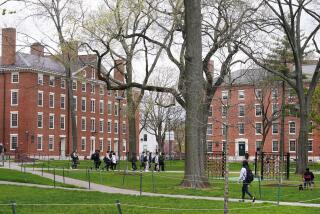Minorities Taking More Academic Classes : Education: U.S. report shows that white high school students are studying fewer such courses, reflecting a two-decade trend.
- Share via
WASHINGTON — White high school students are taking more non-academic classes even as black, Latino and Asian students have increased their academic course work, according to a new statistical portrait of U.S. education released Tuesday.
The decline in academic course work by white students reflects a two-decade trend in many school districts to offer more non-academic electives, education specialists said. And the rising number of academic courses taken by minorities suggests that many of the nation’s poorer districts are now offering more such courses and in some cases stressing them over vocational training.
The report shows that in 1969, 75% of high school courses taken by white students were academic, compared to 69% in 1987. By comparison, the share of academic courses taken by black students rose slightly over that period, from 66% to 68%; among Latino students the rate rose from 62% to 67%; and among Asian students it rose from 68% to 74%.
The 410-page report, “The Condition of Education, 1992,” is one of an annual series. It uses dozens of criteria to evaluate U.S. education. Overall, “there is no single point you can make from this,” Diane Ravitch, the assistant U.S. secretary of education, said at a press conference. “It’s a complicated picture.”
But during an election year in which President Bush’s education record has come under repeated attack, Administration education officials stressed the positive aspects of the education picture. In particular, they seemed to single out the improvements in the educational attainments of women and minorities.
The report showed, for example, that the share of women going from high school to college rose from 43% in 1973 to 62% in 1990. The rate among males, by contrast, rose from 50% in 1973 to 58% in 1990.
There are now more women earning bachelor’s degrees than men among whites, blacks and Latinos, Ravitch said.
“If you look at it historically, what you see is a crossing of the lines,” she said. “Whereas women were at a distinct disadvantage in 1977, women have advanced very rapidly through the educational system in the earning of bachelor’s degrees.”
The report also pointed to the rising high school completion rates among blacks. In 1990, 78% of black 19- and 20-year-olds had graduated from high school, compared to 68% in 1973. Over the same period, the graduation rate for whites was “largely unchanged” at 87%.
The report showed that academic proficiency in reading, science and math, as measured by the National Assessment of Academic Progress, remains lower for black children than for whites. But the gap has narrowed over two decades: In 1990, black 9-year-olds were 35 scale points behind whites in reading, compared to 44 points in 1970.
The report also hinted that the status of students who do not speak English well may have improved over the last decade.
Between 1979 and 1989, the share of such students who were behind in grade level fell 15%.
But as it described some improvements in education, it also pointed to difficulties. The report showed that in international tests, 9- and 13-year-old American students scored lower on math and science assessments than students in Korea, Taiwan and the former Soviet Union.
The report suggested rising rates of crime in the schools. More than 16% of 12- to 19-year-olds reported seeing a teacher attacked, or threatened with attack, in the last six months.
More to Read
Sign up for Essential California
The most important California stories and recommendations in your inbox every morning.
You may occasionally receive promotional content from the Los Angeles Times.














